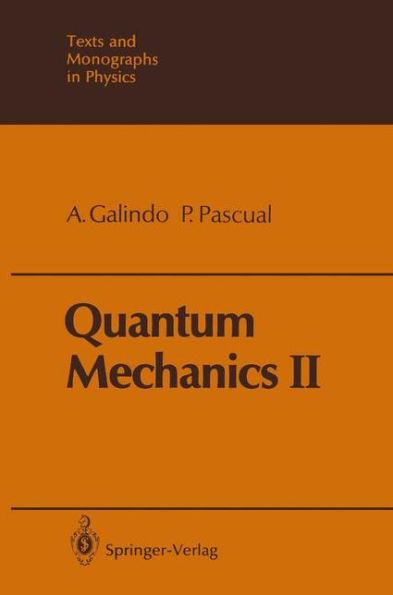5
1

Quantum Mechanics II
374
by Alberto Galindo, Luis Alvarez-Gaume (Translator), Pedro Pascual
Alberto Galindo

Quantum Mechanics II
374
by Alberto Galindo, Luis Alvarez-Gaume (Translator), Pedro Pascual
Alberto Galindo
Paperback(1991)
$99.99
-
PICK UP IN STORECheck Availability at Nearby Stores
Available within 2 business hours
Related collections and offers
99.99
In Stock
Overview
This is a textbook on non-relativistic quantum mechanics that emphasizes clarification of the nature of the basic postulates and the interpretation of the theory. It contains special material, often only accessible in scientific journals, on bound states, scattering theory, and both analytical and approximation techniques. Applications to many branches of physics are given. Among the topics covered are one-dimensional problems, angular momentum, two-particle systems, symmetry transformations, collision theory, the WKB method, and stationary and time-dependent perturbation and variational techniques. Particles in an electromagnetic field, many-body systems, atoms, and radiation theory are studied. The book is a considerably improved and completely updated English translation of a very successful Spanish textbook and is aimed at students in their second year of university.

Product Details
| ISBN-13: | 9783642841316 |
|---|---|
| Publisher: | Springer Berlin Heidelberg |
| Publication date: | 01/06/2012 |
| Series: | Theoretical and Mathematical Physics |
| Edition description: | 1991 |
| Pages: | 374 |
| Product dimensions: | 6.10(w) x 9.25(h) x 0.03(d) |
Table of Contents
8. Scattering Theory.- 8.1 Introduction.- 8.2 General Description of Scattering Processes.- 8.3 Cross Sections.- 8.4 Invariance of the Cross Section. Change LAB— C.M..- 8.5 Simple Scattering: Classical Case.- 8.6 Simple Scattering: Quantum Case.- 8.7 Scattering Operator or S Matrix. Unitarity of the S Matrix.- 8.8 Intertwining Property and Energy Conservation.- 8.9 d?/d? as a Function of TE.- 8.10 Scattering into Cones.- 8.11 The Optical Theorem.- 8.12 Computation of the Scattering Amplitude.- 8.13 Space-Time Description of Simple Scattering.- 8.14 Symmetries of the Scattering Operator.- 8.15 Scattering by a Central Potential: Partial Waves and Phase Shifts.- 8.16 Computation and Properties of Phase Shifts.- 8.17 Scattering by a Central Square Well.- 8.18 Analyticity Properties of the Partial Amplitudes.- 8.19 Analyticity Properties of the Scattering Amplitude.- 8.20 Coulomb Scattering.- 8.21 Two Body Elastic Scattering.- 8.22 Multichannel Scattering.- 8.23 General Form of the Optical Theorem.- 8.24 Symmetries in Multichannel Scattering.- 8.25 The Optical Potential.- 9. The W.B.K. Method.- 9.1 Introduction.- 9.2 The W.B.K. Method in One-Dimensional Problems.- 9.3 Connection Formulae.- 9.4 Bound State Energies.- 9.5 The Potential Barrier.- 9.6 The Miller-Good Method.- 9.7 Transmission by Double Potential Barriers.- 9.8 Potential Wells: Several Turning Points.- 9.9 Central Potentials.- 10. Time-Independent Perturbation Theory and Variational Method.- 10.1 Introduction.- 10.2 Time-Independent Perturbations. The Non-Degenerate Case.- 10.3 The Harmonic Oscillator with—x4 Perturbation.- 10.4 The Harmonic Oscillator with—x3 Perturbation.- 10.5 Two-Electron Atoms (I).- 10.6 Van der Waals Forces (I).- 10.7 Kato’s Theory.- 10.8 The Stark Effect.- 10.9 The Variational Method.- 10.10 Two-Electron Atoms (II).- 10.11 Van der Waals Forces (II).- 10.12 One-Electron Atoms.- 10.13 Eigenvalues for Large Coupling Constants.- 11. Time-Dependent Perturbation Theory.- 11.1 Introduction.- 11.2 Nuclear Spin Resonance.- 11.3 The Forced Harmonic Oscillator.- 11.4 The Interaction Picture.- 11.5 Transition Probability.- 11.6 Constant Perturbations.- 11.7 Turning on Perturbations Adiabatically.- 11.8 Periodic Perturbations.- 11.9 Sudden Perturbations.- 11.10 The Adiabatic Theorem.- 11.11 The Adiabatic Approximation.- 11.12 The Decay Law for Unstable Quantum Systems.- 12. Particles in an Electromagnetic Field.- 12.1 Introduction.- 12.2 The Schrödinger Equation.- 12.3 Uncertainty Relations.- 12.4 The Aharonov-Bohm Effect.- 12.5 Spin-1/2 Particles in an E.M. Field.- 12.6 A Particle in a Constant Uniform Magnetic Field.- 12.7 The Fine Structure of Hydrogen-Like Atoms.- 12.8 One-Electron Atoms in a Magnetic Field.- 13. Systems of Identical Particles.- 13.1 Introduction.- 13.2 Symmetrization of Wave Functions.- 13.3 Non-Interacting Identical Particles.- 13.4 Fermi Gas.- 13.5 Bose Gas.- 13.6 Creation and Annihilation Operators.- 13.7 Correlation Functions.- 13.8 Superfluidity.- 13.9 Superconductivity.- 14. Atoms.- 14.1 Introduction.- 14.2 The Thomas-Fermi Method.- 14.3 The Hartree-Fock Method.- 14.4 The Central Field Approximation.- 14.5 Perturbative Calculations.- 14.6 Russell-Saunders or LS Coupling.- 14.7 jj Coupling.- 15. Quantum Theory of Radiation.- 15.1 Introduction.- 15.2 Plane Wave Expansions.- 15.3 Quantization of the E.M. Field.- 15.4 Multipole Waves.- 15.5 Interaction Between Matter and Radiation.- 15.6 Transition Probabilities.- 15.7 Emission and Absorption of Photons.- 15.8 Angular Distribution of Multipole Radiation.- 15.9 Electric Dipole Transitions in Atoms.- 15.10 Radiative Transitions in Nuclei.- 15.11 Low Energy Compton Scattering.- of Quantum Mechanics I.From the B&N Reads Blog
Page 1 of
